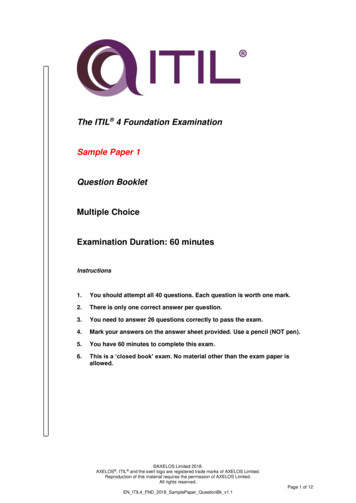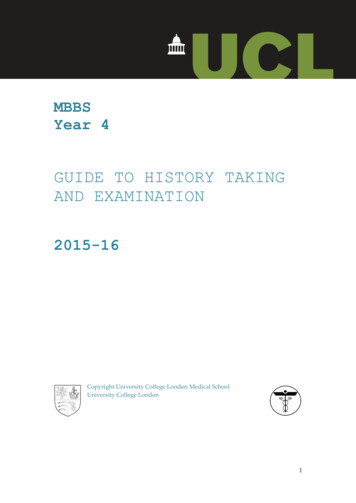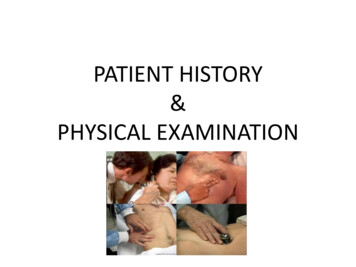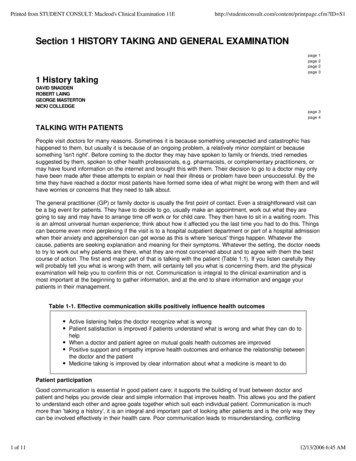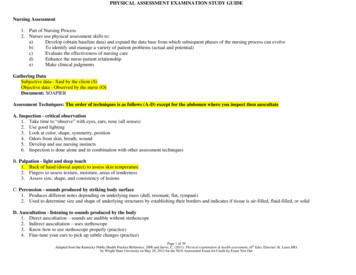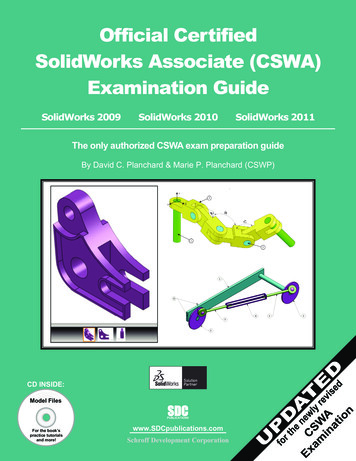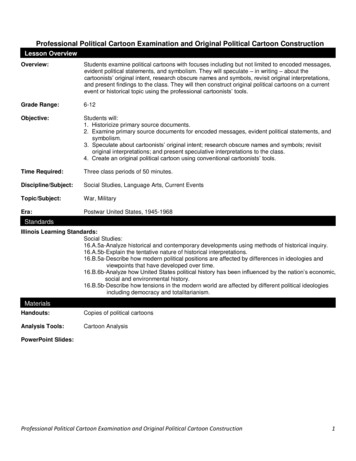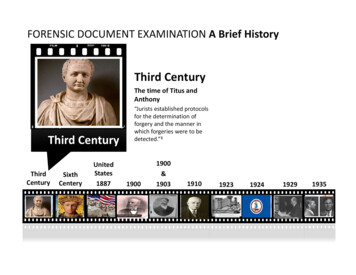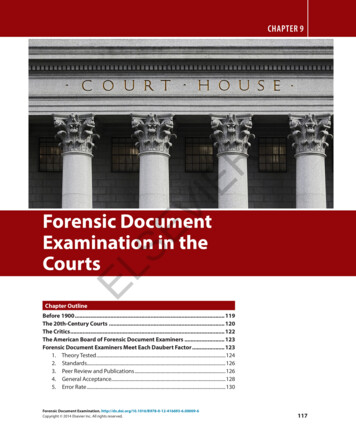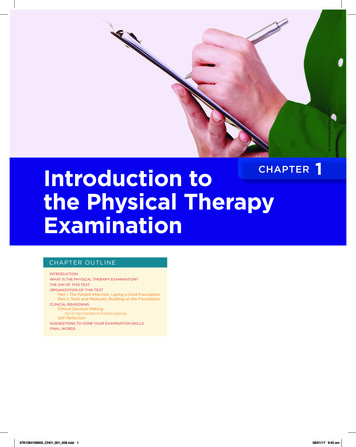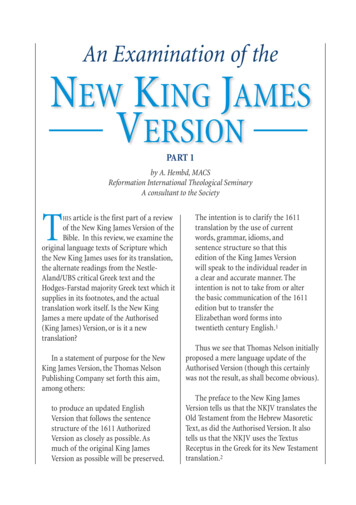
Transcription
Issue Number: 581 – October to December 2007An Examination of theNEW KING JAMESVERSIONPART 1by A. Hembd, MACSReformation International Theological SeminaryA consultant to the SocietyTHIS article is the first part ofa reviewof the New King James Version of theBible. In this review, we examine theoriginal language texts of Scripture whichthe New King James uses for its translation,the alternate readings from the NestleAland/UBS critical Greek text and theHodges-Farstad majority Greek text which itsupplies in its footnotes, and the actualtranslation work itself. Is the New KingJames a mere update of the Authorised(King James) Version, or is it a newtranslation?In a statement of purpose for the NewKing James Version, the Thomas NelsonPublishing Company set forth this aim,among others:to produce an updated EnglishVersion that follows the sentencestructure of the 1611 AuthorizedVersion as closely as possible. Asmuch of the original King JamesVersion as possible will be preserved.The intention is to clarify the 1611translation by the use of currentwords, grammar, idioms, andsentence structure so that thisedition of the King James Versionwill speak to the individual reader ina clear and accurate manner. Theintention is not to take from or alterthe basic communication of the 1611edition but to transfer theElizabethan word forms intotwentieth century English.1Thus we see that Thomas Nelson initiallyproposed a mere language update of theAuthorised Version (though this certainlywas not the result, as shall become obvious).The preface to the New King JamesVersion tells us that the NKJV translates theOld Testament from the Hebrew MasoreticText, as did the Authorised Version. It alsotells us that the NKJV uses the TextusReceptus in the Greek for its New Testamenttranslation.29
Trinitarian Bible Society – Quarterly RecordRelatively speaking, the New King JamesVersion is better than the other modernversions because its actual text is not basedon the modern critical Greek text. Yet wemust also state firmly that we do not deemit a faithful translation. Indeed, we cannotrecommend it at all. We must to thecontrary note its following grave defects:impact of the changes made by the NKJV isheightened when one considers theinclusion of the readings of the NestleAland/UBS text in the NKJV margin. Thesemarginal readings make potential doctrinalimpacts upon key doctrines such as theincarnation of Christ and His eternalGodhead, as we shall itemise.In the New Testament, the NKJV presentsa textual apparatus, alongside its translation,with readings from the Nestle-Aland criticalGreek text, the text from which the NewInternational Version, the New AmericanStandard Bible, the Revised StandardVersion and the vast majority of modernversions are translated. The textual apparatusalso includes variant readings from the socalled Byzantine majority text which is anedition of the Greek text edited byZane Hodges and Arthur Farstad (Dr Farstadwas also the editor of the New King JamesVersion). The presentation of thesevariant readings would make it appearthat the Textus Receptus is not reliable,and that therefore, by implication, theAuthorised Version, which used theTextus Receptus in Greek for its NewTestament translation, is itself suspect.We now consider the New King JamesVersion translators’ equivocal andduplicitous commitment to the TextusReceptus of the Greek. We quote thefollowing from David Cloud’s Web sitearticle entitled What about the New KingJames Version? It should be noted that we donot personally endorse all that Mr Cloudhas to say concerning the Providentialpreservation of the text. Nonetheless, wemust take note of what he relates belowconcerning the executive editor of the OldTestament of the NKJV, and how that editorviews the Received Text of the NewTestament:Instead of staying as close to the text ofthe Authorised Version as possible, as theguidelines originally stated, the New KingJames translators made many unnecessarytranslational changes and mostly for theworse, as we shall demonstrate. Contrary towhat the original purpose was stated to be,the NKJV is a new translation, not a merelanguage update. Not only that, thetranslation changes impact key doctrines ofthe Scripture, such as the eternalpunishment of the lost in hell. The doctrinal10We have corresponded with theexecutive editor of the Old Testamentportion of the NKJV, Dr James Price.In April of 1996 he admitted to methat he is not committed to theReceived Text and that he supportsthe modern critical text in general:‘I am not a TR advocate. I happento believe that God has preserved theautographic text in the whole body ofevidence that He has preserved, notmerely through the textual decisionsof a committee of fallible men basedon a handful of late manuscripts. Themodern critical texts like NA26/27[Nestle-Aland] and UBS [United
Issue Number: 581 – October to December 2007Bible Societies] provide a list of thevariations that have entered themanuscript traditions, and theyprovide the evidence that supportsthe different variants. In theapparatus they have left nothing out,the evidence is there. The apparatusindicates where possible additions,omissions, and alterations haveoccurred I am not at war with theconservative modern versions [suchas the New International Version andthe New American StandardVersion]’. (James Price, e-mail toDavid Cloud, April 30, 1996).3For about a century most havefollowed a Critical Text (so calledbecause it is edited according tospecific principles of textualcriticism) which depends heavilyupon the Alexandrian type of text.More recently many have abandonedthis Critical Text (which is quitesimilar to the one edited by Westcottand Hort) for one that is moreeclectic. Finally, a small but growingnumber of scholars prefer themajority text, which is close to thetraditional text except in theRevelation.5So there you have it. The executive editorof the Old Testament of the New King JamesVersion does not advocate the Greek TextusReceptus at all; he is an advocate of theNestle-Aland critical Greek text, by his ownadmission. Not only that, the principaleditor overall of the New King JamesVersion, Arthur L. Farstad, was also coprincipal editor, along with Zane Hodges, ofthe Hodges-Farstad majority text, a Greektext that makes nearly 1,900 changes tothe Textus Receptus.4 No wonder theeditors of the New King James wish topresent us with their textual apparatus ofalternate Greek readings; they do not believein the Textus Receptus, they advocate otherGreek texts! Says Dr Farstad in his prefaceto the New King James:Thus, we see that Dr Farstad deprecatesthe Textus Receptus. New Testament textualcriticism is in a state of flux, he tells us; theold is no longer good, he implies. Very fewscholars still favour that old-fashioned TextusReceptus, which was once universallyrecognised by the Church as theProvidentially preserved and pure text of allages, and which once held universal sway asthe Byzantine text for 1,400 years, the lastnearly five hundred years as the printedTextus Receptus.6 But no, we must now setaside that old-fashioned text; we must turninstead to the Greek texts favoured by thereal scholars: either to the critical text,which is favoured by most, or to the new socalled Byzantine majority text which isfavoured by an increasing minority ofscholars. Thus, the editors of the NKJV willnow do us a great favour by setting forth tous these better readings in the margin, thesebetter readings which they have given inEnglish in the margin, these better readingswhich overthrow and undermine theauthority of the translation from the TextusReceptus we see in the main body of the text.Today, scholars agree that the scienceof New Testament textual criticism isin a state of flux. Very few scholarsstill favor the Textus Receptus assuch, and then often for its historicalprestige as the text of Luther, Calvin,Tyndale, and the King James Version.11
Trinitarian Bible Society – Quarterly RecordWhat we have just said is nooverstatement, but is a necessaryconsequence of what Dr Farstad has said.Apparently the Textus Receptus is no longerto be regarded as the Providentiallypreserved Greek text because it wascompiled by a ‘committee of fallible men’using ‘a few late manuscripts’, as Dr Pricehas told us. If, as we are told by Dr Farstad(who was co-editor of the Hodges-Farstadmajority Greek text which is at majorvariance with the Textus Receptus in over1,000 places), that scholars today hold forthe most part to either the critical text orthe majority text and therefore those textsare better than the Textus Receptus, thenone of those texts and a translationmade from one of those texts should bewhat we read. Therefore, it follows that theTextus Receptus, and its faithful translation,the Authorised Version, should be set aside.Statement of the overallpurpose of this paperWe endeavour, the Lord helping us, toaddress the matters set forth above, alongwith the translational problems of the NKJV,in the following manner:1. We shall show the critical text for what itis: a recovery of the Alexandrian text of the4th century AD, which is an Egyptianrevision and corruption of the Apostolic text.Therefore, we will affirm that it is wrong forthe New King James Version to include textcritical notes in its margin from this verycorrupt text. We shall demonstrate the verycorrupt state of the Egyptian text, byutilising the meticulous textualexaminations of it by Herman Hoskier,12especially from his work Codex B and itsAllies,7 as well as from other sources. Weshall demonstrate that the Egyptian orAlexandrian text was corrupted by thefollowing things, among others: (1) it wascorrupted by the superimposition of Coptic(i.e., Egyptian) spellings, grammaticalstructures, and word order upon the text;(2) it was corrupted in many places by there-editing of the Apostolic Greek text tomake it match the Coptic (Egyptian) text;(3) it was corrupted by the critical work ofthe early Church Father Origen and hisfollowers, who often critically amended thetext according to their mystical/allegoricalinterpretations of passages of Scripture; andfinally, (4) it was corrupted by heretics inEgypt who emasculated the text in key places.2. In the second place, we shall demonstratehow the Church at large, after thepersecutions of the 2nd and 3rd centuries,and particularly after the Council of Niceain the 4th century, began to revise theirmanuscript copies universally to thestandard of the faithful apographs (copiesdescended directly from the originals) thatwere yet maintained in the apostolicchurches of Asia Minor (which was theByzantine Empire) and of Rome, and hence,set forth the rise of the Byzantine text to theascendancy, and the universal rejection ofthe Egyptian text for the next 1,400 years.3. In the third place, we shall show how theTextus Receptus was the result of faithfulmen who laboured to see that the best textfrom the copies of the traditional text foundits way into the printed editions, that manyeyes were on the text to correct it, and thatthe Reformation fathers were right in eightpassages in the Textus Receptus to follow a
Issue Number: 581 – October to December 2007Greek minority reading8 when that readingwas backed with nearly universal Latinsupport; and that thereby, throughconsulting an overwhelming Latin witness,the true readings were restored universallyon the printed page.4. We in the fourth place shall show that theso-called Byzantine majority texts of bothHodges and Farstad, and Pierpont andRobinson, are fatally flawed, in that, by theirown confession,9 their editors reliedprimarily upon the work of BaronHermann von Soden and his text of 1913.Herman Hoskier, an advocate of thetraditional text, cites in his 1914 review ofvon Soden’s text in the Journal ofTheological Studies indisputable proof thatvon Soden’s Greek text is, in his words,‘honeycombed with errors’.10 SimilarlyFrederick Wisse, who is himself verysympathetic of von Soden’s aims thoughfrank about his inaccuracies, says that‘ von Soden’s inaccuracies cannot betolerated for any purpose. His apparatus isuseless for a reconstruction of the text ofthe MSS he used’.11 Accordingly, we shallcite specific instances from both Hoskierand Wisse that fully demonstrate the errorsand inaccuracies of the von Soden text, andtherefore also of the Hodges-Farstadmajority text and the Pierpont-Robinsonmajority text. Therefore, we must censurethe New King James Version for includingthe error-riddled readings of the so-calledmajority text in its margins.5. We shall then, as enabled, address thetranslational flaws of the NKJV in both theOld and New Testaments. We shalldemonstrate that these flaws are not minorin nature, but that, to the contrary, togetherwith the marginal notes, they impact keydoctrines of the Word of God: doctrinessuch as the hypostatic union of the twonatures in Christ, the incarnation, theeternal generation of the Person of the Son,the divinity of Christ, and the eternalpunishment of the wicked in hell.6. In the last place, we shall exhort ourreaders to cling to the tried and provenAuthorised Version, and, where difficultiesare encountered with archaic language,simply to use a commentary like MatthewHenry’s (which is now free online) todetermine the meaning.In this instalment, we hope to cover thefirst two points. We shall cover them in apanoramic history of the text, and then weshall enlarge on point one, namely, thecorruption of the Egyptian text, and with itthe Nestle-Aland/UBS text, bydemonstrating its corruption from theEgyptian translations of the New Testament,by demonstrating the corrupting influenceof Origen upon that text, and bydemonstrating the emasculating influencesof heretics upon certain of its texts. We nowproceed, and may the Lord help us in thismost important endeavour.The corruption of theEgyptian text provenFirst, we consider the corruption of theEgyptian text, which is commonly called theAlexandrian text, after Alexandria, Egypt,which was a centre of Greek learning and oftextual criticism, it being founded byAlexander the Great on the coast of theMediterranean.13
Trinitarian Bible Society – Quarterly RecordThe corruption of the Egyptian Greektexts can be seen in many ways—by thehigh numbers of contradicting variationsamong its own texts, by the high numbers ofCoptic (Egyptian) spellings, by theimposition of Egyptian word order on thetext, by the Greek text being made to followthe Coptic (especially the Sahidic orSouthern Coptic); and by its beingdeliberately altered by Origen and hisfollowers and by outright heretics. Butbefore we consider these materialevidences, we must consider the most surewitness—the Word of God itself. What doesthe Word of God say of its own preservationand how this preservation would come tobe? Do we not have a ‘thus saith the LORD’?We consider, then, Isaiah 59.20–21: ‘Andthe Redeemer shall come to Zion, and untothem that turn from transgression in Jacob,saith the LORD. As for me, this is mycovenant with them, saith the LORD; Myspirit that is upon thee, and my words whichI have put in thy mouth, shall not depart outof thy mouth, nor out of the mouth of thyseed, nor out of the mouth of thy seed’sseed, saith the LORD, from henceforth andfor ever’.We may notice the following from the text:1. The Redeemer Christ the Lord ispromised to come to Zion, the Church, tothem that turn from transgression in Jacob.We must understand by Zion both theChurch Invisible and Visible—both as theChurch which is composed of true, bornagain believers, and also as that Zion whichhas an outward form, with ordinances, moreor less pure: the faithful preaching of theWord, the keeping of the sacraments as14instituted in the Word of God, and churchdiscipline rightly maintained.2. The promise that the Lord makes to Zionis that His words, which He has put in theirmouth, shall not depart out of their mouth,nor out of the mouth of their seed, nor theirseed’s seed, from henceforth, even for ever.Likewise, His Spirit which is upon themshall abide with them for ever.3. The significance of the Lord’s wordsbeing in their mouth is that His Word, Hisinspired Word, would be confessed publiclyby them, and fed upon by them, with themouth of faith, and that in all generations.Now, we note that the above promise isnot made to individual believers,considered as individual believers per se.The promise is rather made to Zion, to theChurch. Thus, though there may have beenindividual true believers, particularlyduring the times of persecution, who didnot have the purest text, yet the purest textremained in Zion as a whole. In time thattext prevailed over the other texts, we mightsay, as Aaron’s rod prevailed over the rods ofthe magicians of Egypt. Thus it is that,though we see distinctive (and corrupted)textual readings in the papyri and uncial(similar to capital letters) texts—in whatwe now call the Alexandrian and Westerntext families—which were preserved in thesands of Egypt from the 2nd, 3rd, and 4thcenturies, yet by the end of the 4th centurythe text which we call the Byzantine textascended and prevailed over all the others.The Church Fathers from Chrysostom of the4th century AD onward we find universallyquoting the Byzantine text, the text thatprevailed in the area we now call Asia
Issue Number: 581 – October to December 2007Minor, then called the Byzantine Empire,over which Byzantium was the capital. Itwas this locale where most of the churchesfounded by the apostles themselves were—Colossae, Thessalonica, Ephesus, Philippiand Corinth. We may believe that this wasthe text that prevailed amongst those verychurches. Indeed, this was so because, asTertullian of Carthage tells us in thebeginning of the 3rd century, faithfulapographs, precise copies of the apostolicoriginals, were maintained in the apostolicchurches as the standard for all copies.In his famous The Prescription againstHeretics, Tertullian says:Chapter XXXVI. The ApostolicChurches the Voice of the Apostles.Let the Heretics Examine TheirApostolic Claims, in Each Case,Indisputable. The Church of RomeDoubly Apostolic; Its Early Eminenceand Excellence. Heresy, as Pervertingthe Truth, is Connected Therewith.Come now, you who would indulgea better curiosity, if you would applyit to the business of your salvation,run over the apostolic churches, inwhich the very thrones of the apostlesare still pre-eminent in their places,in which their own authenticwritings are read, uttering the voiceand representing the face of each ofthem severally. Achaia is very nearyou, (in which) you find Corinth.Since you are not far from Macedonia,you have Philippi; (and there too) youhave the Thessalonians. Since you areable to cross to Asia, you get Ephesus.Since, moreover, you are close uponItaly, you have Rome, from whichthere comes even into our own handsthe very authority (of apostlesthemselves).12 [emphasis added.]Notice that Tertullian speaks of theapostolic churches—Philippi, Corinth,Thessalonica, Ephesus, Rome—where the‘thrones of the apostles are still eminent’,which is to say, where there were stillfaithful presbyters who were pastors overthose congregations and who were yetteaching and preaching the apostolicdoctrine. Not only that: notice also thatTertullian tells us that the authenticwritings of the apostles themselves werestill read in those churches.What does Tertullian mean by ‘authenticwritings’? He means that there were yetfaithful apographs, that is, precise copies,or perhaps even the autographs or originalcopies themselves, in those churches, andwhich the presbyters read from everyLord’s Day.Given that the Church Fathers even inTertullian’s day found many variations intheir texts through copyists’ errors, towhence do we think they would have lookedto correct their copies? Why, of course: tothe ‘authentic copies’ which were yetmaintained in ‘the apostolic churches’.And where were these apostolicchurches? Outside of Rome, they were allin the area of the Byzantine Empire.From the writings of Tertullian we haveextant, we know that he was fluent inGreek, but that, he being from Africa—from Carthage—his New Testament copies15
Trinitarian Bible Society – Quarterly Recordwere primarily of a ‘Western’ text-type.13What do we mean by the terms‘Alexandrian’ or ‘Western’?The Alexandrian text, with its distinctivereadings, came primarily from Alexandria,Egypt, though its origin was actually fromsouthern Egypt—near the Nag Hammadilibraries, where the Sahidic or Southerndialect of the Egyptian or Coptic languagewas spoken. We know this because of theaffinity of the Alexandrian text for the earlySahidic Coptic translation of the Bible. Inmany instances, we may believe that verseswere directly translated from the SahidicCoptic back into the Greek, and we shallgive instances of this shortly.The Western text was so called, notbecause it was from the west but ratherbecause it is a text that also came fromAlexandria, Egypt, from a different schoolof textual criticism within that city. But thattext-type ended up being translated intothe Old Latin versions and into the LatinVulgate, which were then used by most ofthe churches of the Latin west after the 5thcentury AD. We see the early Church FatherClement of Alexandria, in the 3rd centuryAD, primarily quoting a Western text;hence, we know the origin of that family oftext to have been from Alexandria.14 (TheWestern text may also have been influencedby the Old Latin versions that were thencurrent in northern Africa.) But we alsoknow that the Latin versions weresubsequently all related to this text, andbecause the Latin versions became theBible used by the western churches ofEurope for a time, that text family came tobe known as the Western text. (The earliestLatin versions came from Africa, not Rome.16The Old Latin versions came from northernAfrica, and worked their way up intoEurope, as C. P. Hallihan well notes in theQuarterly Record.15)Tertullian had copies that primarilyreflected a Western text, as were most of thecopies in northern Africa where he lived.But Tertullian was very limited in his choiceof text. The age in which he lived—the late2nd and early 3rd centuries AD—saw timesof great persecution. Many were martyred.Christians were not free to travel. Believers,particularly in Egypt and Africa, did nothave free access to the authentic copies thatwere yet maintained in the apostolicchurches within the Byzantine Empire.Thus, corruptions entered the manuscriptsfor a time, particularly in Egypt and Africa,through copyist errors, through outrightemendations of the text, and throughheretics who wilfully corrupted the SacredText. But always, the saints like Tertullianpointed to what standard? To the ‘authenticcopies’, as he called them, which were storedin the apostolic churches in the area aroundByzantium. That he did so, we see from hisown words in Prescription against Heresieswhich we already have quoted. Thus, a verystrong case can be made for believing thatTertullian himself would much haveapproved the Church’s return to theByzantine text readings which began inthe 4th century AD.A misunderstanding byDr Harry Sturz cleared upAt this point, we must address a statementby Dr Harry Sturz concerning the Biblicaldoctrine of Providential preservation.
Issue Number: 581 – October to December 2007Dr Sturz is a refreshing voice in manyways amongst modern Biblical textualcritics. He at least would give the Byzantinetext a fair hearing. We certainly mustwarmly commend his work entitled TheByzantine Text-Type and New TestamentTextual Criticism, where he lists 150 specificinstances of Byzantine readings in theEgyptian papyri which are extant from thefirst four centuries. That said, however, it isclear from his book that he does notcompletely understand the Scriptures (hecertainly did not understandIsaiah 59.20–21) and what they sayconcerning their own preservation.Dr Sturz says (in trying to respond toquoted statements of Dr Edward Hills):One is tempted to ask: how can God’sprovidence be limited to men of theByzantine area? For example, there isno question about the belief ofIrenaeus, Origen, and Augustine inthe inspiration of the Scriptures. ButIrenaeus used a ‘corrupt’ Western text,and Origen and Augustine arepainfully aware of variants in theirmanuscripts. Athanasius wascertainly orthodox, and he used aGreek text, yet it was Alexandrian anddifferent from the text of Antioch ofthe 4th century. These men werebelievers and took a supernaturalview of the text of Scripture, and yet,in God’s providence, they used textsother than the Byzantine.16In answer to this, we must say that, as wehave shown from Isaiah 59.20–21, Godmade a covenant to preserve His word, notwith every individual true believer, butrather with believers consideredcorporately as Zion—the Church of God.It was with this Church (that is with Zion)that God made this covenant, for theRedeemer’s sake, and it is with this Churchthat God fulfilled that covenant.We have seen how Tertullian used aWestern text primarily, and yet Tertullianalso clearly pointed to the Byzantine textmaintained in the apostolic churches in theauthentic copies as being the true standard.Thus, we must be persuaded that Tertullianhimself, and not only Tertullian but alsoIrenaeus (but not Origen, as the reader willshortly see for himself) would havefavoured the movement of the Church inthe 4th century to restandardise all thecopies to conform to the faithful apographsmaintained in the apostolic churches (whichwere, for the most part, within theByzantine Empire).There were several factors that hadpreviously prevented the standardisation ofthe Greek text, several of them political andecclesiastical in nature. There were certainlythe ten persecutions against the Christianscarried out by the Roman emperors in thefirst three centuries and in the beginning ofthe fourth—the last one, that of Diocletian,being the worst. There was also the Arianheresy, which had dominion in the universalChurch for about forty years after thepersecutions and which continued to be adominant force in the Church until theEmperor Justinian crushed it by conqueringthe Lombards, the Vandals and theOstrogoths—three Arian kingdoms—inAD 533.17 Prior to this, there had been anArian influence upon the copies of the NewTestament in Egypt, as we shall see.17
Trinitarian Bible Society – Quarterly RecordThere was also the influence of Origenand the Origenists, which had favoured amystical/allegorical interpretation of theScriptures, and which also had modified thetexts to favour their interpretations. TheByzantine emperor Justinian also broughtan end to the influence of Origenism whenhe called the council of Constantinople inAD 543, which condemned Origen andOrigenism, particularly Origen’s heresy ofuniversal redemption (that all souls, after athousand years of purgatory, would besaved). Certainly, the facts that: (1) theEgyptian text differed from the apographswhich had been maintained in theByzantine apostolic churches; (2) Egypt,notwithstanding that there were championsof orthodoxy within her midst, nonethelessalso had many heretics within her who wereknown to have tampered with the text; (3) itwas well known that Origen had altered theEgyptian text, and that he with his followershad just been condemned by a Council inByzantium in AD 543; and (4) the entireCoptic (that is, Egyptian) Church wasexcommunicated from the communion ofthe orthodox churches in the 5th centurybecause of their monophysitism18 (whichthey have named miaphysitism19)—thesefacts, we affirm, would have caused theorthodox churches to look askance, andrightly so, at the Egyptian text. So, duringthe 5th century, all hands agree that theByzantine text gained dominance20—theChurch began to shelve the Egyptian text,and to promote copies after the apostolic,Byzantine standard—and that by the 9thcentury all remnants of the Alexandrian textin essence died out. It was no longer in themouth of any segment of the Church at all,save the Coptic Church and her allies, whohad universally been excommunicated in18the 5th century for refusing to comply withthe Council of Chalcedon.We are thus persuaded that the earlyChurch universally embraced the standardof Tertullian—namely, that the truereadings of New Testament Scripture wereto be found in the faithful apographs orcopies of the apostolic congregations, wherethe apostolic pastorates were still in place.We believe that, after the persecutionsceased, and Arianism, Nestorianism,Monophysitism and Origenism were routed,the Byzantine text rightly gained theascendancy and that permanently, thusmanifesting itself to be the text that wouldbe the Scriptures in the true Church’smouth, from generation to generation, evenfor ever, in accordance with the promise ofIsaiah 59.20–21.The Egyptian text cannot bethe Providentially preservedtext, because it was notpreserved in all generationsnor in the Church’s mouthin all agesWe have shown that the true text, the wordsof God promised in Isaiah 59.20–21, wouldbe that which would be in the mouth of thetrue Church, in the mouth of her seed andher seed’s seed, from henceforth and forever. Thus, any text that was obliterated andforgotten for 1,400 years cannot byScriptural standards be the Providentiallypreserved words of God, because it was notthe text that was in the Church’s mouth, thatis, in her profession and in her feeding upon
Issue Number: 581 – October to December 2007it as it was being expounded from herpulpits from generation to generation. Ofcourse, where the Alexandrian and Westerntexts agree with the Byzantine text, thosereadings were preserved, those words werepreserved—but not the distinctiveAlexandrian or Western readings. They werenot preserved from generation to generationin the Church’s mouth, in her confession andpreaching, because they simply were not theProvidentially preserved words of God.Thus, the Egyptian text cannot be theProvidentially preserved words of God, savewhere it agrees with the Byzantine
King James Version, the Thomas Nelson Publishing Company set forth this aim, among others: to produce an updated English Version that follows the sentence structure of the 1611 Authorized Version as closely as possible. As much of the original King James Version as possible will be preserved. The intention i

